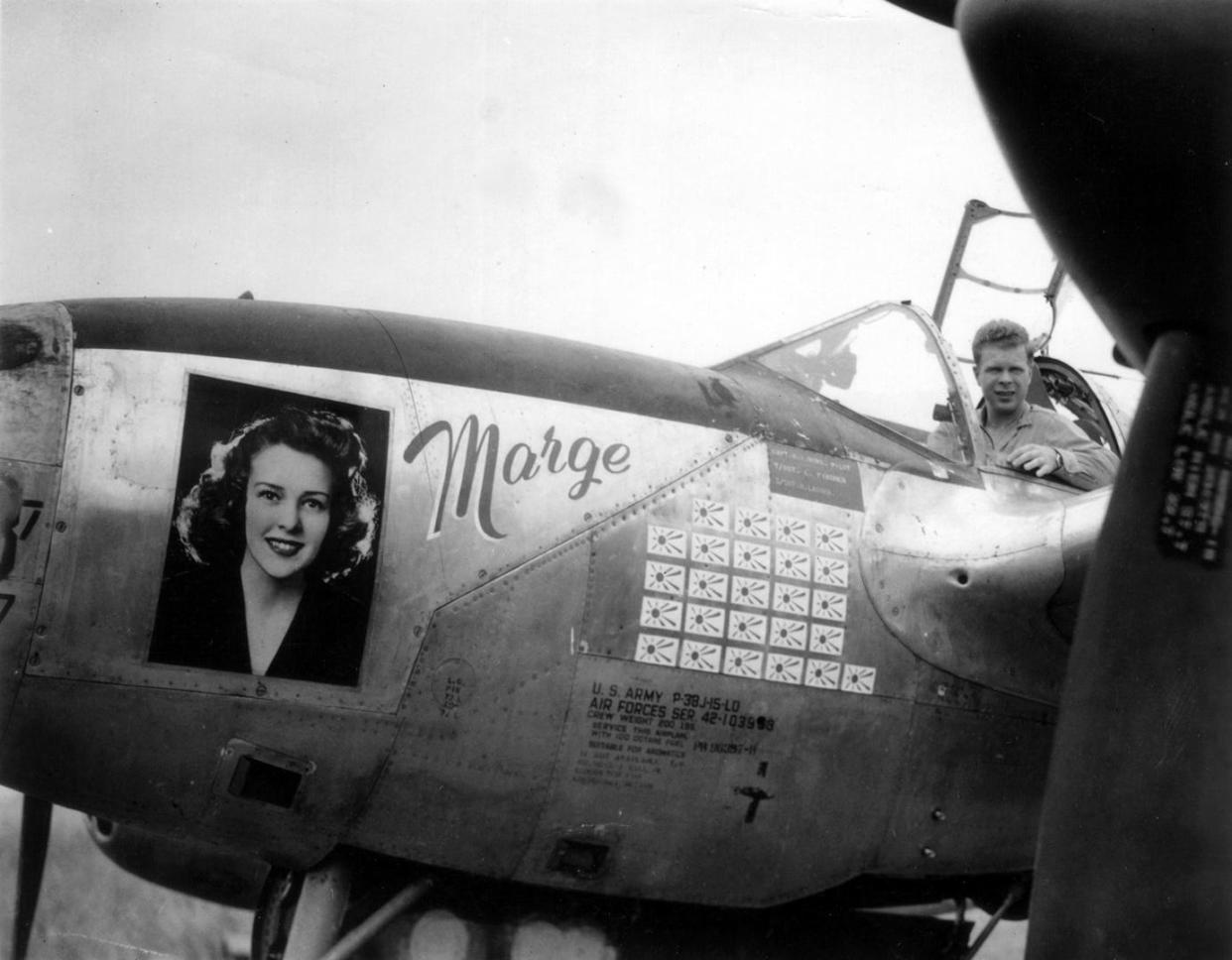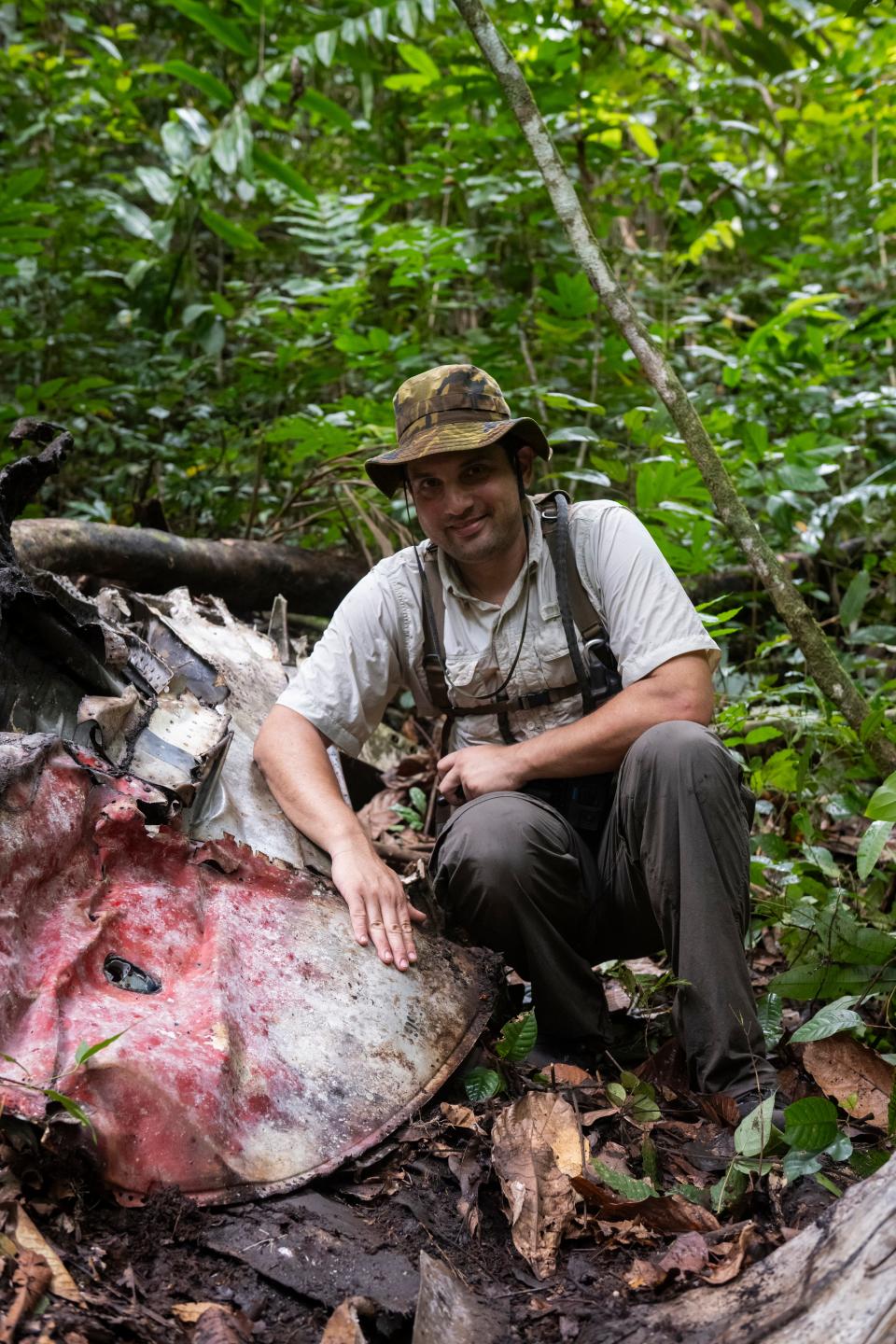Search team finds plane once flown by a Wisconsin WWII hero, 'Ace of Aces' Richard Bong

- Oops!Something went wrong.Please try again later.
The jubilation the search team felt when it discovered "Ace of Aces" Richard Bong's downed P-38 Lightning fighter plane in a South Pacific jungle reverberated more than 8,000 miles away in northern Wisconsin.
Briana Fiandt, the curator of collections and exhibits at the Richard I. Bong Veterans Historical Center in Superior, opened photos and video clips from Pacific Wrecks on May 17. The museum had hired the U.S.-based nonprofit group, which locates the remains of missing in action military members and historically-significant planes, ships and other equipment lost during World War II, to find the plane.
Just hours earlier, they did, and photos showed the remnants of the twin-engine Lockheed P-38J Lightning, including its serial number, 42-103993.
Bong, who grew up in Poplar, flew the plane in combat and shot down one enemy fighter and two enemy bombers in it. He would eventually destroy a total of 40 enemy aircrafts in combat, becoming America's top ace in not only World War II, but for all time.
The plane was nicknamed "Marge," because Bong had a portrait of his girlfriend at the time, Marjorie "Marge" Ann Vattendahl, painted on the nose of the aircraft. The team found the aircraft in the Madang Province of Papua New Guinea, an island country that was used as an Army Air Force base of operations throughout the war.
Fiandt watched the clips and scrutinized the pictures with a rush of elation. "Oh my gosh, my jaw just dropped, and I was so excited. This was the best-case scenario," Fiandt said. "They found the serial number and everything."
The only thing better, Fiandt said, would have been if the team could have found the remnants of the "Marge" portrait, but more than 80 years in the wilds of the South Pacific erased that possibility.

Who was Richard Bong?
Bong was a "quiet, modest and plain, maybe, farm boy," said his nephew Jim Bong, 60, a fighter pilot himself, who flew F-15 jets in the U.S. Air Force from 1990 to 2013.
Richard Bong's demeanor stood in marked contrast from the personalities of many fighter pilots, Jim Bong said. "A lot of them can be flamboyant, cocky and loud. But he was modest. A go-get-the-job done, calm, cool and collected kind of guy."
After growing up, Richard Bong enlisted in the Army to become a flying cadet in Wausau on May 29, 1941, according to an Air Force biography. He deployed to the Pacific in November 1942 and by April 1944, he had amassed 28 enemy aircraft kills. He was promoted from captain to major and sent to Texas to train other pilots.
In September 1944, he returned to the Pacific and was a gunnery training officer. The job meant that he no longer needed to fly in combat, but he voluntarily flew 30 more missions over Borneo and the Philippine Islands, destroying 12 more enemy planes.
Among the honors Richard Bong would receive for his valor: the Distinguished Service Cross, two Silver Stars and the Medal of Honor, America's highest military decoration. After leaving combat, Richard Bong became a test pilot for the P-80 jet fighter. He died in August 1945 when his plane's engine failed over Burbank, California.

What is significant about the P-38 Lightning and why did it crash on Papua New Guinea?
This particular P-38 Lightning was built in 1943 and assigned to Richard Bong in the middle of February of 1944, according to a fact sheet jointly compiled by Pacific Wrecks and the Richard I. Bong Veterans Historical Center. By the middle of March 1944, Bong had the portrait of Vattendahl (who he would later marry) painted on its nose. Photos of Bong with the plane became famous across the country, as Bong's exploits were well reported and he was already a war-time celebrity.
"The airplane itself was real famous," Jim Bong said.
It came to be wrecked on Papua New Guinea on March 24, 1944. Richard Bong was sent to nearby Australia to bring back another plane, Fiandt said. While he was gone, 2nd Lt. Tom Malone used the "Marge" P-38 to fly a weather reconnaissance mission. He encountered bad weather and the fighter plane struggled with mechanical issues, including engine failure. Malone was able to bail out of the plane, but the P-38 crashed.
Malone wasn't injured in the incident, and was found by soldiers of the 32nd Division, which included a lot of soldiers from Wisconsin and other Midwest states, Fiandt said.
Malone "got back to the base and he was fine. But of course, he had to tell Bong that he crashed the plane," Fiandt said. By all accounts, Bong was gracious about the loss, and even said he had noticed some mechanical difficulties with the plane the last time he had flown it.
What's next in the saga of Richard Bong's P-38 Lightning?
The "Marge" P-38 is owned by the state of Papua New Guinea, so officials there have ultimate say in its fate. But Jim Bong and Fiandt hope that an arrangement can be made to bring back a piece of the wreckage to be displayed at the Bong Veterans Historical Center.
Even if that doesn't happen, the effort to find the airplane was worth it, Fiandt said. The museum contracted with Pacific Wrecks in the search effort, and the team has provided the historical center with photos, videos and other information. Fiandt aims to use that material to create a documentary and an exhibit that museum visitors can see.
But she said, maybe the most important part of the effort was that it found a tangible piece of Richard Bong's story that can be used to help spotlight his legacy.
"I think it's unfortunate that Richard Bong has been, in the eyes of the general public, forgotten. But within the aviation community, he still is very much revered. ... But the plane represents the sacrifice and bravery and all of the things that the men and women who fought were."
Meanwhile Jim Bong said that there is talk of the Pacific Wrecks team returning to the crash site, and he would like to accompany them if they do. "Let's see where we can go from there," he said. "For me, and I think a lot of our family, it would be really nice if we could get a piece of it for the museum here."
Keith Uhlig is a regional features reporter for USA TODAY NETWORK-Wisconsin based in Wausau. Contact him at 715-845-0651 or kuhlig@gannett.com. Follow him at @UhligK on X, formerly Twitter, and Instagram or on Facebook.
This article originally appeared on Green Bay Press-Gazette: P-38 Lightning cements legacy Wisconsin's Richard Bong Ace of Aces

